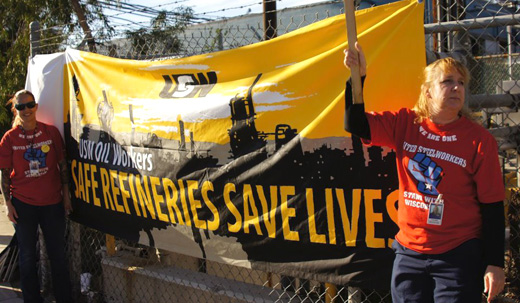
A PAI SPECIAL REPORT, PT. II:
WASHINGTON – The fatal BP oil refinery explosion in Texas City, Texas, in March 2005 reflected not just safety problems at the nation’s oil refineries, but problems with refinery regulation – problems that continue.
The blast killed 15 people and injured 170 more. After investigation, the Occupational Safety and Health Administration fined BP a record total of $72 million in 2005 and 2009.
But the second segment of OSHA’s fine was because BP didn’t fix the problems at Texas City, which Marathon Oil now owns. And the lack of a fix is symptom of yet another problem: Inadequate oversight and regulation of the nation’s refineries.
In mid-2009, top Obama Labor Department official Jordan Barab, a former union safety and health director, sent letters to management of more than 100 oil refineries nationally, critiquing them on process safety management (PSM), the top-to-bottom comprehensive review of all production processes at a plant, taken as a whole, to ensure they’re safe.
His letters showed each refinery its PSM “compliance issues” and reminded them to obey PSM standards designed to make an entire plant, and all its systems, safer for workers. Barab pointed them towards OSHA directives on the issue or said they could contact local OSHA offices for guidance.
But OSHA is so short-staffed, say the Steel Workers, who represent the workers at Texas City and other refineries in the Houston-Galveston corridor, that an average U.S. refinery would get a PSM inspection once every 120 years.
“We initiated this National Emphasis Program to ensure that refineries develop and fully implement a safety management system that protects workers from serious incidents,” Barab explained in releasing the letter. “Our inspection teams were repeatedly seeing the same problems at the refineries. We found it necessary to remind employers of the importance of compliance with OSHA standards that are designed to save workers’ lives.”
In short, it isn’t just BP and Marathon, say both Barab and Kim Nibarger, the safety and health director for the oil workers’ sector of USW. “Things are kind of regressing” in Texas City “and that’s a pretty common industry trait. The problems are nationwide” Nibarger says.
Congress helps little, he adds. The oil industry “is extremely powerful and has a lot of politicians in their pocket. Poor OSHA: They’re undermanned and underbudgeted.”
The problem is bigger than the public suspects. The figure of “46 fires and explosions a year” USW cites comes from the industry’s own reports to the feds. “Those are the self-reported fires. They don’t count the ones they don’t report,” Nibarger adds laconically.
Nibarger said the Obama administration is trying to do something about safety and health problems at refineries, specifically citing the National Emphasis Program and an Obama executive order this past August covering refineries and other chemical plants.
The order set up a federal cabinet-level Chemical Facility Safety and Security Working Group “to create comprehensive and integrated standard operating procedures for a unified federal approach for identifying and responding to risks in chemical facilities,” it says.
That includes risks “during pre-inspection, inspection execution, post-inspection, and post-accident investigation activities-incident reporting and response procedures, enforcement, and collection, storage, and use of facility information. This shall reflect best practices and shall include agency-to-agency referrals and joint inspection procedures where possible and appropriate,” and “consultation…on post-accident response.”
A second large accident in 2012, in Richmond, Calif., killed nobody, but 15,000 area residents needed medical treatment. Gov. Jerry Brown, D-Calif., then commissioned an interagency report on safety, health and environmental hazards from refineries there.
“Gaps in the regulatory schemes exist, including limitations on their ability to cover all aspects of process safety and the extent to which they are enforceable,” the California report says. “Regulatory agencies face multiple issues relating to inspection and enforcement capabilities including: Difficulty in hiring, retaining, and training inspectors; lack of mechanisms for information sharing and coordination; deficiencies in data and transparency; and insufficient penalties to create meaningful deterrence.”
California’s OSHA is short-staffed, too. The Public Employees for Environmental Responsibility asked federal OSHA earlier this year to move against Cal/OSHA’s short-staffing, which flunks federal standards. The state has 170 job safety and health inspectors for 18.6 million workers, including refinery workers.
Jack Gerard, president of the American Petroleum Institute – the oil industry’s lobby – defends his members’ safety record. Gerard says independent outside auditors review the industry’s safety standards and best practices. He adds the oil companies, including BP and Marathon, are constantly upgrading their plants and that API “does not play to the lowest common denominator.”
And “what regulators do is adopt our standards,” Gerard says. “So as we continue to improve our (safety) technology, they pick it up and make it a rigorous standard.” Critics dispute that conclusion. They say the regulated industry is co-opting regulators.
And refinery explosions and accidents, unless they’re big and dangerous, don’t get publicity, which is often the most valuable deterrent. “The more the public knows about how these facilities are being run, the more pressure shines on them to make sure” there’s no backsliding after accidents and that they’re run right in the first place, Nibarger says.
Photo: USW Local 13-1 Facebook page.










